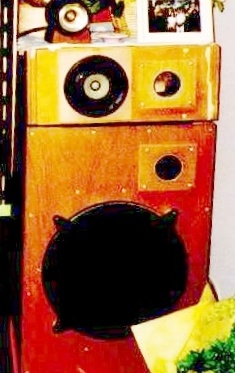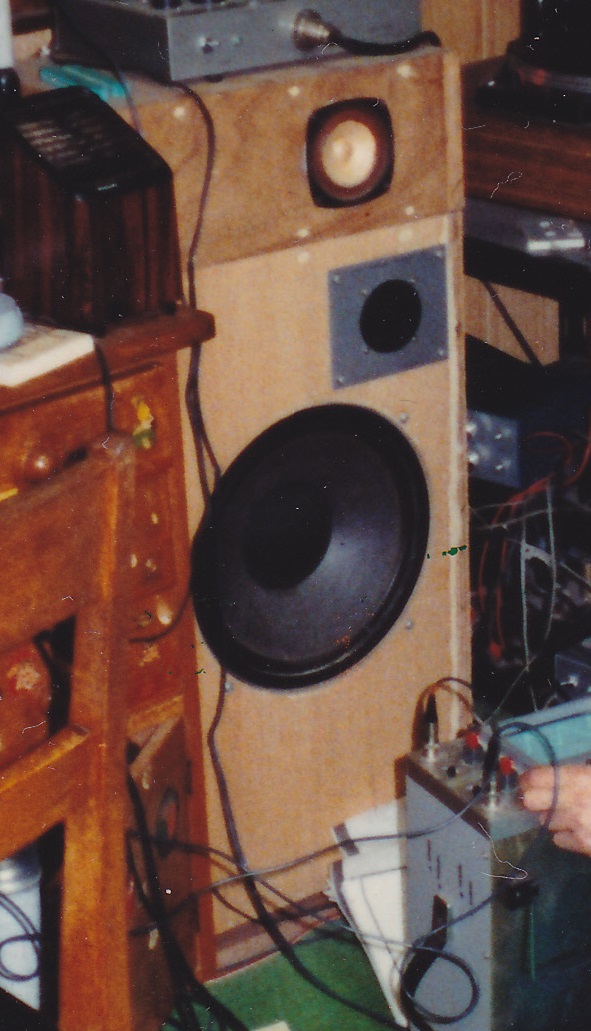SS-307
2011/04/03 created
2021/12/05 updated
Three-way Speaker System
Multi-enclosure speaker system for multi-amplifier audio system

| Features | Network is not included -- dedicated design for multi-amplifier audio system. Multi-enclosure system for easy upgrading. Using full-range LS unit as squawker -- can be used as single LS unit system. |
|---|---|
| Outline Specifications | Enclosure type: Vented (squawker box, woofer box). Frequency range: 25Hz-40kHz. Sensitivity: Tweeter: 108dB/W, Squawker: 90dB/W, Woofer: 95dB/W (at 1m) |
| Dimension | Squawker box: 400(W) x 185(H) x 270(D) mm. Weight: ?kg. Woofer box: 400(W) x 710(H) x 290(D) mm. Weight: ?kg. |
| Cost | aprrox. 120,000 JPY |
| History | Built in 1982. Improved in 1984 (Rev.A), 1993 (Rev.B), 2000 (Rev.C). Discarded in 2001. |
The following contents were copied from the page of SS-307 on my previous homepage 'Tonochi's Audio Room', and edited to fit in the new format.
Concept
Three-way loudspeaker system that meets the requirements specified in the
Gaudi system design.
Multi-enclosure scheme is employed to make future upgrades easy.
Design
Selection of Key Parts
I chose used loudspeaker units (LS unit), because I didn't have a deep
pocket. So the range of the selection was limited.
As for the woofer, I had decided to use a 30cm (12 in.) woofer in the system design. I looked
for used ones in a good condition. I happened to find a pair of Pioneer
PW-A31 in a classified ad of an audio magazine (MJ). The ad said the pair was
nearly new. The seller was an audiophile living in the same prefecture.
I contacted him without hesitation and he agreed to sell them to me. I
don't remember the price exactly, though, it may have been the half of
the original price.
For the squawker, I chose Fostex FE106 Sigma (4 in. full-range) I had bought for another loudspeaker. Because I couldn't
afford horn units at that time, though they were cheaper than today.
I employed dome tweeters instead of horn type, since dome type was a lot cheaper. It was a Technics.
I forgot the model number. It looked like an expensive one. I bought them
at a junk shop in Akihabara. I forgot the price too, though, it must be
cheap. The specification was unknown, but I decided to use them, since
tweeters with lower sensitivity than the woofer can be used in multi-amplifier
systems.
- Woofer: Pioneer PW-A31 (30cm/12")
- Squawker: Fostex FE106 Sigma (10cm/4" Full-range)
- Tweeter: Technics ? (dome type)
All the LS units were replaced afterward for upgrading. I replaced the
tweeters with long-sought horn tweeters. But I couldn't afford midrange
horn units until I got ones for next loudspeakers (SS-309).
The final configuration was as follows:
- Woofer: Fostex FW305 (30cm/12")
- Squawker: Fostex 6N-FE88ES (8cm/3.5" full-range)
- Tweeter: Fostex T925 (horn-loaded)
I selected 21mm-thick lauan plywood boards for the enclosure material, because it was available at a nearby lumber shop and easy to cut. I didn't consider other materials.
Design of the Woofer Box
I designed a slit vent bass reflex scheme for the enclosure of the woofer (woofer box). The slit vent has high air resistance and damps resonate of the vent. I expected tight bass sound.
I designed the slit vent according to my "textbook", written
by Japanese audio experts and edited by Dr. Takeo Yamamoto of Pioneer Corp
(Ref-8).
Though dimensional error affects the characteristics of the slit vent more
than those of ordinary pipe vents, I didn't care much about it.
The tweeter is mounted in the woofer box.
The Technics dome tweeter is designed to be mounted on the baffle from
behind. Without counterboring, it would be deeply sunk from baffle surface.
So I made sub-baffles of an aluminum board.
The sub-baffle is mounted on the main baffle, and the tweeter is mounted
on the sub-baffle.
Not to take trouble, I didn't paint the woofer box.
Design of the Squawker Box
I didn't take account of bass response since it is the midrange module, though the LS unit is full-range type. This enclosure is a sealed-box and relatively large for FE106 Sigma. A filling is stuffed to prevent standing waves.
The squawker box isn't painted, either.
Building
I cut the plywood boards with a power circular saw I borrowed from my friend. I made the cutouts for the LS units with a padsaw.
Self-evaluation

I was unable to check the operation of the bass reflex vent, because I
didn't have measurement skill at that time. But I was impressed by its
extended and powerful lows. I thought it was a good decision I chose the
large woofer.
Thanks to the deep bass, Hard rock music became one of my favorite kinds,
though I hadn't liked it until then. Especially, I was charmed by The Knack's
My Sharona (FM air check).
There was one catch. The bass sound was dull. I think it was caused by
poor sound quality (SQ) of PW-A31 around the cross point. The guy who sold
it to me also said he wanted to sell it because he didn't like its dull
sound.
I installed SS-307 in the living room after I got married. My wife complained
a lot about its shabby looks and told me not to place junks like this in
the living room.
I was determined that I would build better looking loudspeakers.
(Photo: newly built SS-307 in 1982)
Improvement
Rev. A: Upgrade of the Tweeter (1984)
The dome tweeter was replaced with Fostex T925 (horn tweeter).
T925 was designed to be placed on the top of the enclosure. I did so.
I left the dome tweeter on the woofer box as a blanking plate. I removed
the wire for the tweeter only.
SQ was significantly improved. Gaudi became a hi-res system just like a
multi-amplifier system.
Rev. B: Upgrade of the Woofer (1993)
I replaced the woofer when one of Pioneer PW-A31 was broken.
At that time, only Fostex and Technics produced 12" woofers among
Japanese audio manufacturers. I chose the most inexpensive one: Fostex
FW305.
The frame diameter of FW305 was smaller than the diameter of the cutout
for PW-A31. So I made sub-baffles for FW305, and attached them on the baffles
of the woofer boxes. The sub-baffle covered the slit vent. I fixed a pipe
vent at the position where the dome tweeter was mounted.
SQ was improved by a notch. Bass was no longer dull.
Rev. C: Upgrade of the Squawker (2000)
I wanted to improve SQ more. I replaced the midrange units.
I had two pairs of full-range units that I happened to spot at an audio
shop at Akihabara District and bought when I went there to purchase audio
parts. They were Fostex 6N-FE103 and 6N-FE88ES. They were both limited-production.
First, I tried 6N-FE103, of which dimension is exactly equal to that of
FE106 Sigma. But I felt SQ was worse.
So I decided to use 6N-FE88ES. Because its frame size was smaller than
the cutout for FE106, I made a sub-baffle and attached it on the baffle
of the midrange box.
I took this opportunity to add a vent to the midrange box. Now the midrange
module could be used as a full-range module too.
SQ was apparently improved. 6N-FE88ES had high SQ in high band as if it
could be used as a tweeter. This fact may improve total SQ.
In return for the good SQ, the looks of SS-307 turned to be worse and worse.
The multiple upgrades made it so patchy.